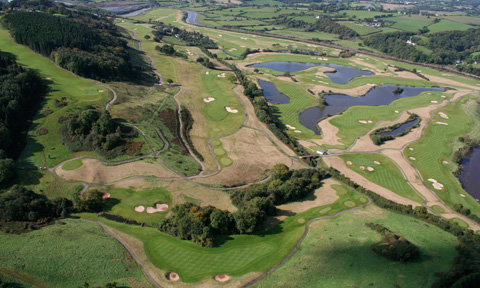距离卡迪夫不到半小时车程的纽波特(Newport)是两千年前罗马人登陆英伦大陆时最先建造的一座城镇。如果说卡迪夫是古罗马人的军事重镇,纽波 特则是古罗马人的“大后方”,那里的竞技场、浴场等遗留的世俗建筑重现了当时人们的消遣娱乐。同为“帝国公民”的遗址,凯尔特庄园向世界宣告了:古罗马人 除了对现代城市与道路建设有着深远影响之外,他们还成就了莱德杯球场历史上最为特别的球场。
世界第三大体育赛事——莱德杯欧美对抗赛首次走进威尔士,承诺完成凯尔特庄园球场的建设是赛事竞标成功的重要筹码。九洞重建,九洞改造,凯尔特 庄园球场光是设计之前的考古阶段就请了将近五十个考古学家进行现场勘探,如何解决古罗马人遗迹的保存已然成为打造莱德杯球场的首要问题。经考古学家评估确 定动土位置之后,如何维持球场现有的生态问题又摆在了眼前。正好赶上睡鼠的繁殖季节,挖掘工程一度推迟,为此球场投入百万英镑聘请专家对当地生态动物栖息 地以及环境进行研究,不仅为睡鼠集体“搬家”,同时为它们搭建了地下的活动通道。
借助原始地势,凯尔特庄园的每个球洞的设计都经过了重复修改的过程,其中17洞、18洞的设计图纸返工次数达到17次之多。在最早的球场设计草 图中,这两个洞都被设计成四杆洞,但是考虑到增加比赛悬念与刺激性,压轴三洞的设计最终调整为四杆洞、三杆洞以及五杆洞。球场采用了古罗马角斗场风格的布 局,就像坐在山谷的露天剧场里看戏,球迷能够充分融入到现场莱德杯两队人马对抗的激情中。除此之外,球场工程还包括清理当地的乌斯克河,在山谷中移山冻土 填平练习场和一号洞(搬运了56吨土)、建造人工湖、更换原有的排水系统以及用了四个月的时间建造了一座停车场等等。
与来自苏格兰(鹰阁、萝梦湖、坦伯利和卡洛斯蒂)、英格兰(斯莱利堂)的球场竞争莱德杯举办权的时侯,凯尔特庄园一度遭到苏格兰对手的嘲笑,甚 至一些威尔士人也认为特瑞-马修想办莱德杯只是一项情愿,他们不相信这个专门为莱德杯而建的球场会比高尔夫的故乡更受欢迎。想象在古罗马人的遗址中坐在露 天的角斗场上看顶级欧美球手的对抗,这种感觉一定不同于在高尔夫故乡看球,无论从镜头中还是在现场,相信凯尔特庄园一定会带给球迷一场特别的视觉盛宴。
The Twenty Ten Course at The Celtic Manor Resort, Newport, South Wales, has been specifically designed to stage The 2010 Ryder Cup.
Opened in July 2007, the course combines nine spectacular new holes designed by European Golf Design with nine holes from the original Robert Trent Jones Jnr-designed Wentwood Hills golf course which have been extensively remodeled. The new course measures 7493 yards from the back tees with a par of 71.
The brief was to create a golf course that could deal with the particular requirements of hosting a Ryder Cup in addition to challenging the world’s greatest players in Tournament competition. Close coordination between European Golf Design and The European Tour Staging Department ensured that the design catered for all the elements needed to stage a major sports event including creating areas for tented villages, building dedicated platforms for hospitality units, incorporating space for all the media and television requirements, providing good spectator viewing points and ensuring practical and safe public access.
Vast platforms for corporate hospitality were constructed running virtually the entire length of the final three holes, while the slopes below these platforms offer superb viewing for thousands of spectators not only of these holes, but across the whole of the golf course.
Ross McMurray, Designer, European Golf Design, said: “It has been a great privilege to play a part in the development of the Twenty Ten Course at Celtic Manor Resort and to have the opportunity to create a golf course that is not only capable of challenging the world’s greatest players but can also deal with all the requirements of staging a Ryder Cup. It has also been an interesting exercise to successfully balance the various requirements of engineers, archaeologists, ecologists and The European Tour Staging Department with the need to create a golf course that will host both The Celtic Manor Wales Open and The Ryder Cup as well as provide a high quality golfing destination for visitors to the resort. It was a real team effort from the start and I would like to thank all those who have been involved in this hugely exciting project.”
The whole course is played along the floor of the Usk Valley affording wonderful views in all directions along the valley and towards Caerleon. Water comes into play on nine holes creating some exciting risk and reward opportunities, an important component of the design given The Ryder Cup’s match play format. Many of the holes have been designed to provide different options for the golfer both from the tee and the fairway and a variety of tees have also been constructed to allow flexibility in the way the holes can be set up. The last three holes have been cut into the lower slopes of the valley and will provide a challenging and dramatic conclusion, particularly at the 18th where players must decide whether to carry a pond in front of the green with their second shot or lay up and leave a tricky pitch from a downhill lie over water to a raised green.
Because of its setting within the Usk Valley the site is particularly sensitive and a tremendous amount of work was done to reduce the impact of the scheme on the environment. Detailed surveys of the ecology of the site were carried out and as a result various elements such as planting corridors and protection buffer zones were included within the landscape design. By using careful management regimes the aim is to encourage greater bio-diversity within the golf course, especially when compared to the previous pastureland, which has a relatively low ecological and landscape value. Particular emphasis has been placed on increasing habitat creation by incorporating a variety of vegetation types, as well as streams, wetlands and planted areas.
In addition to its ecological importance the whole district around Caerleon has an important archaeological heritage and an archaeological survey was therefore on-going throughout the construction works. A number of important roman finds were made and, on a number of occasions the golf course design was adapted to ensure there was no destruction of sites of historical value.
The course made its debut as a tournament venue, playing host to The Celtic Manor Wales Open on May 29–June 1, 2008 with the course, measuring 7352 yards.
Michael King, Director of European Golf Design and former Ryder Cup Player, commented: “We are very excited The Celtic Manor Wales Open is being held on the new Twenty Ten course. This sees the culmination of eight years work for European Golf Design. I know the new course will provide the players with a terrific and enjoyable challenge during The Celtic Manor Wales Open as we head towards The Ryder Cup in 2010.”

